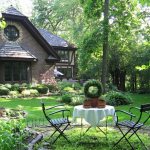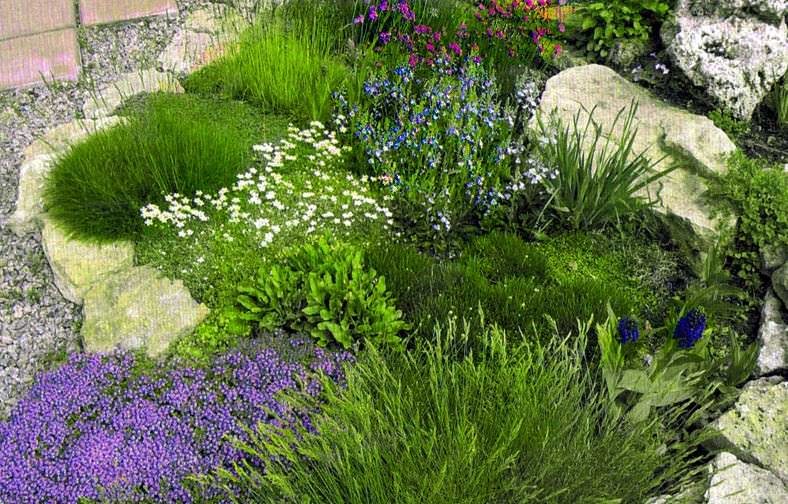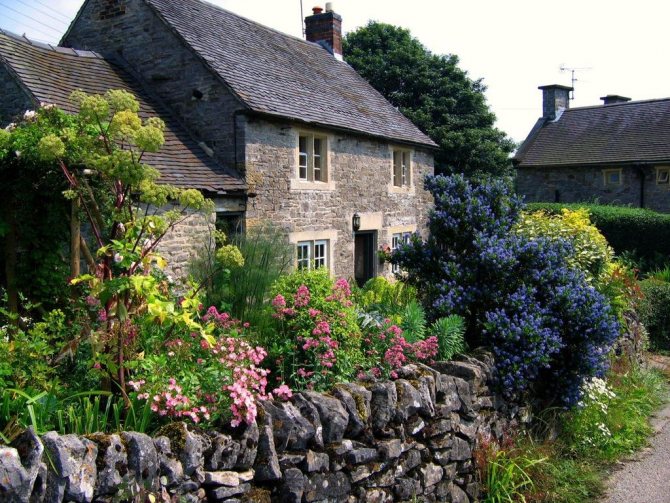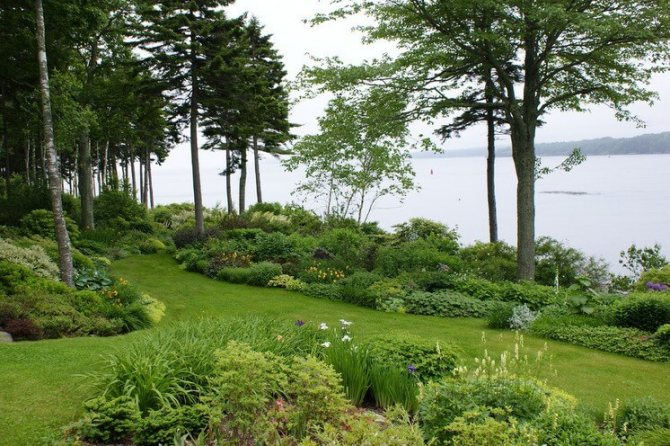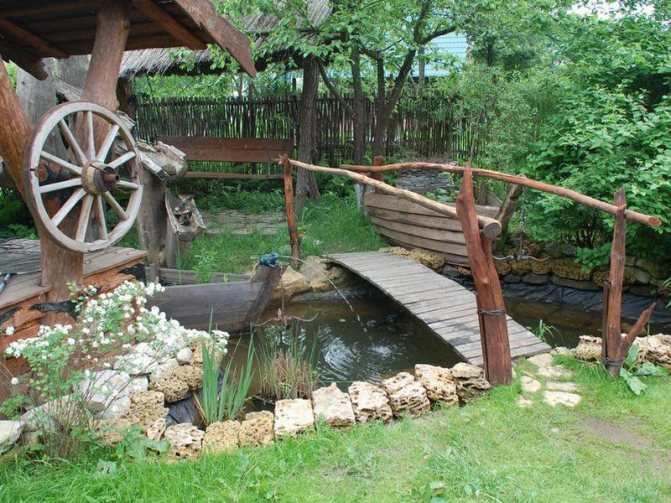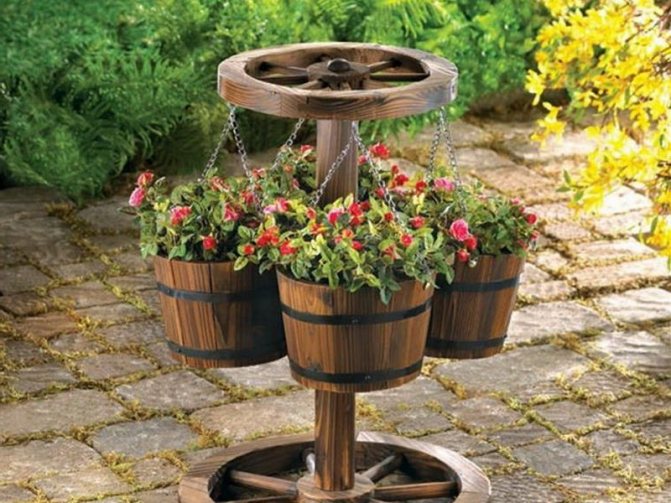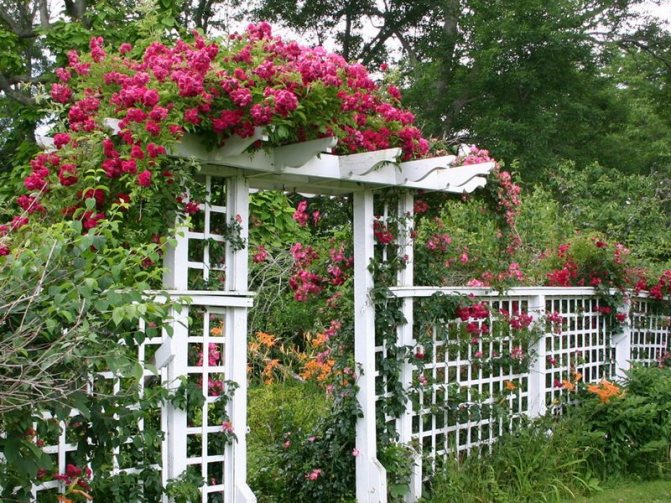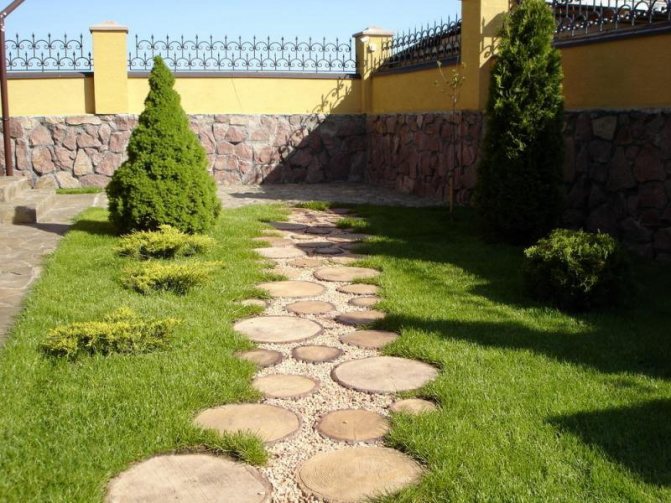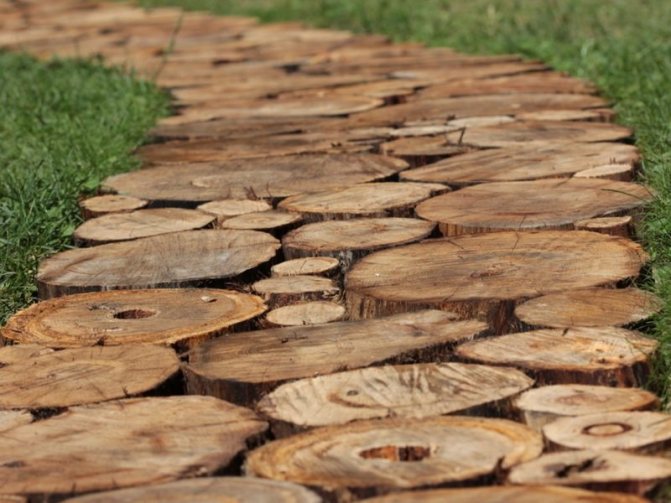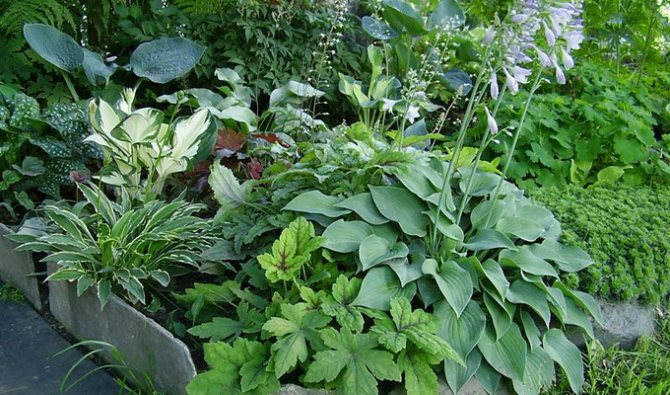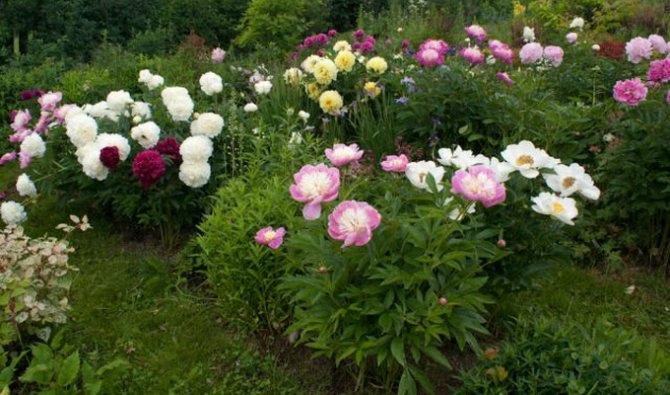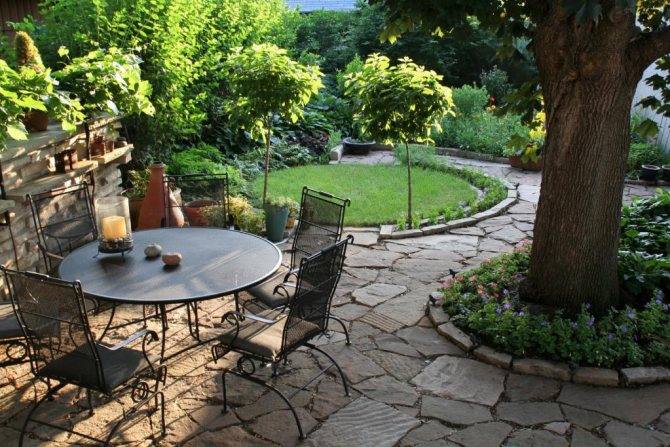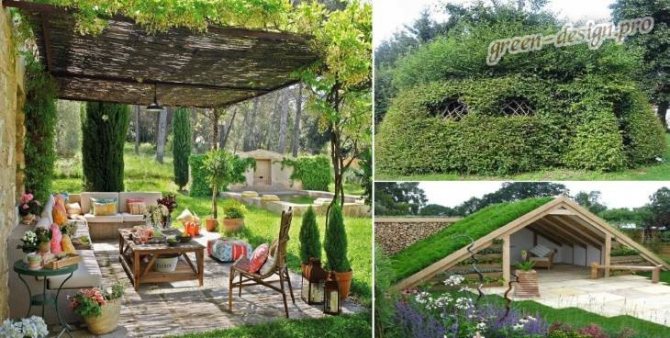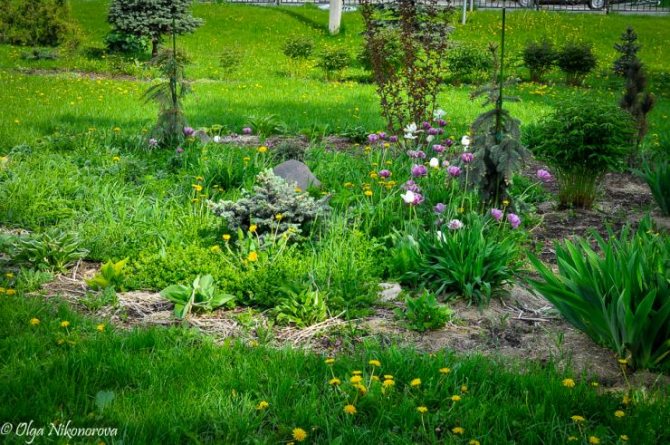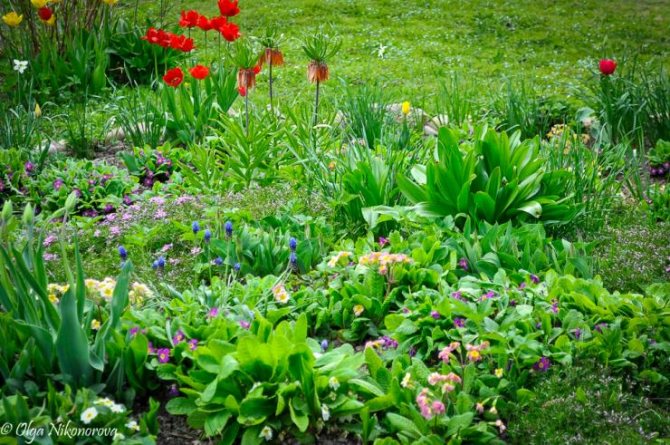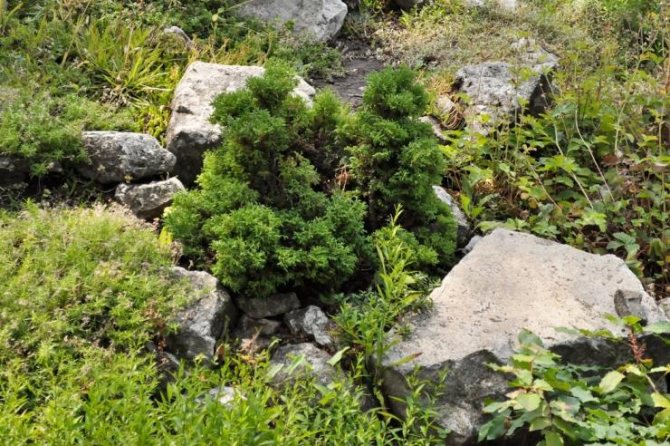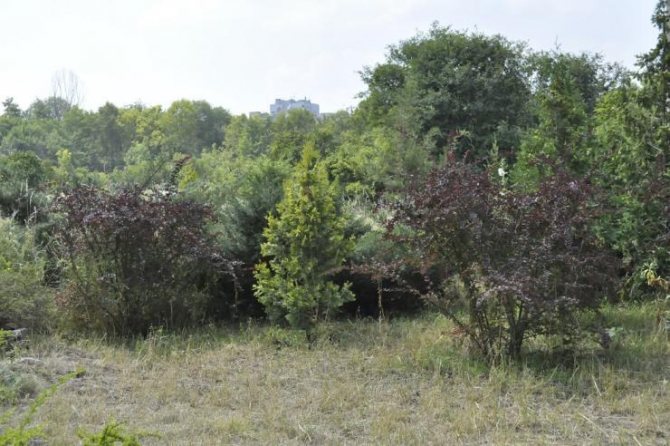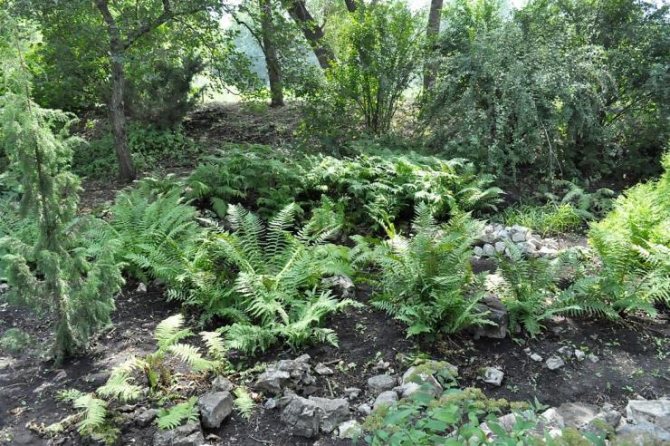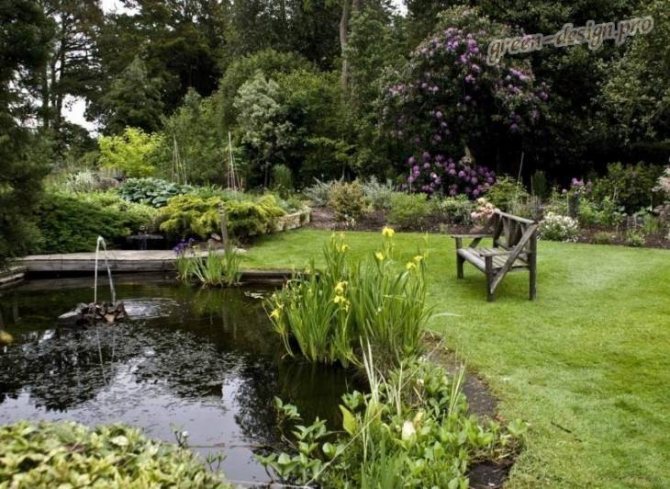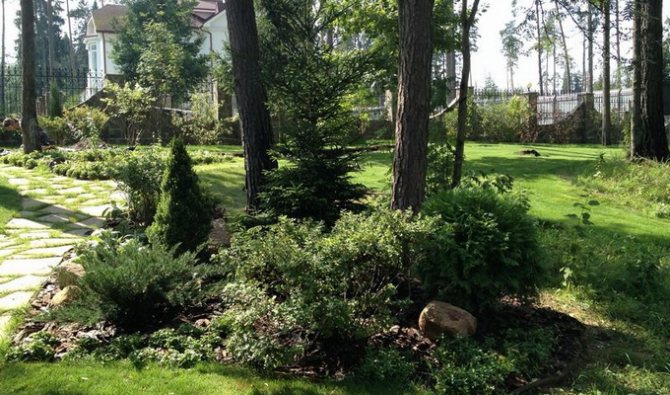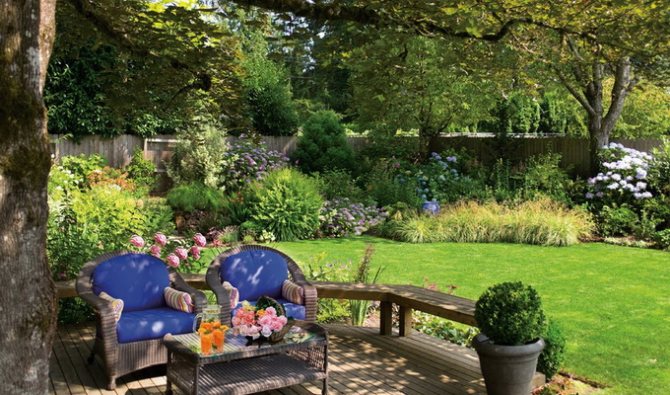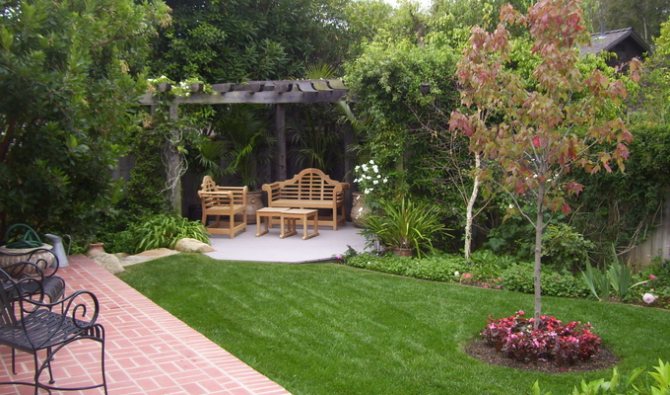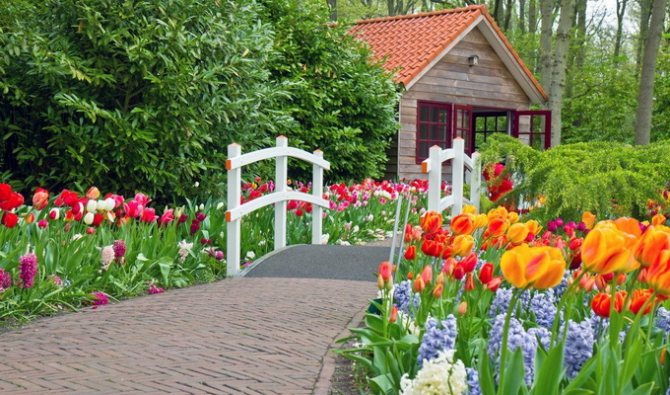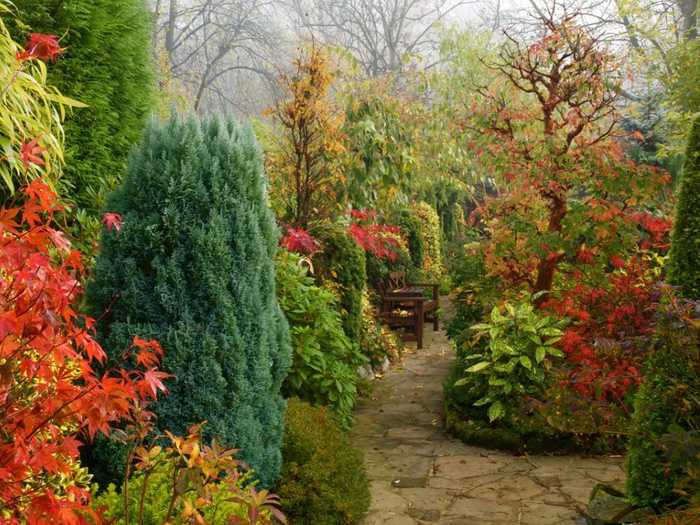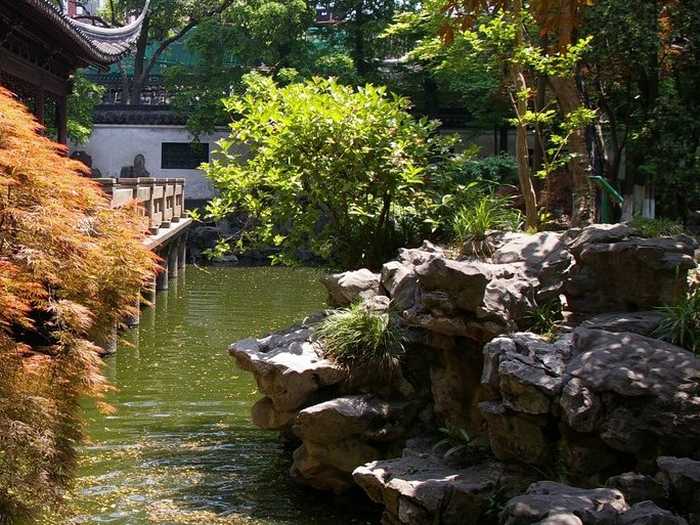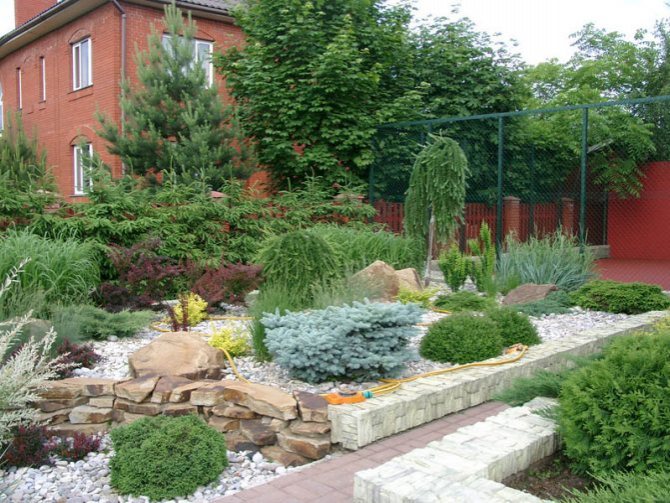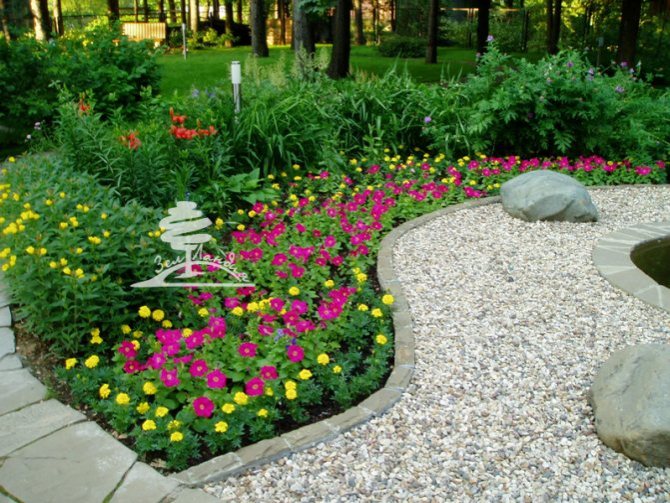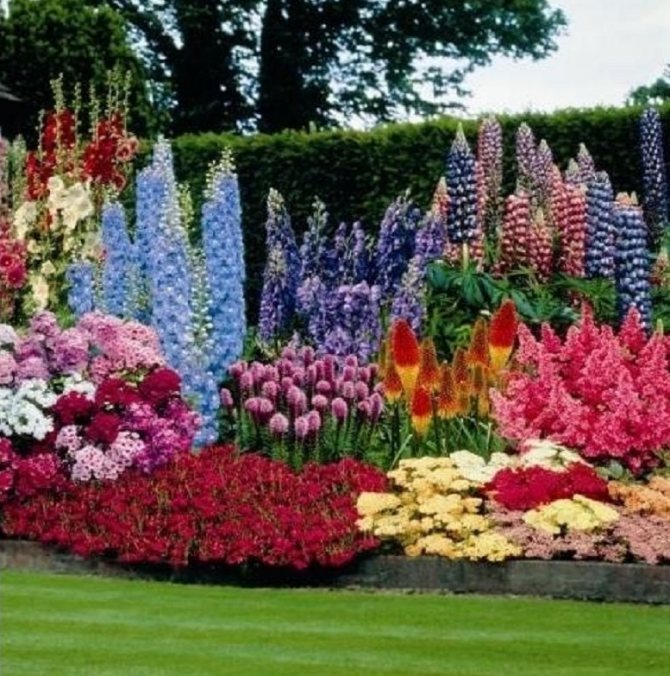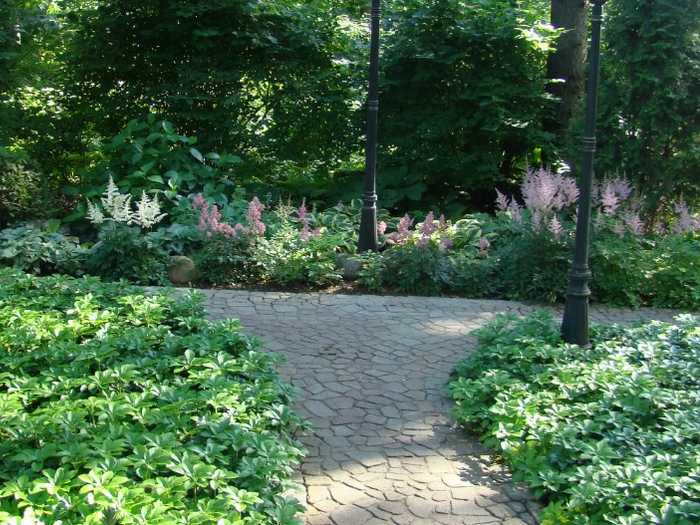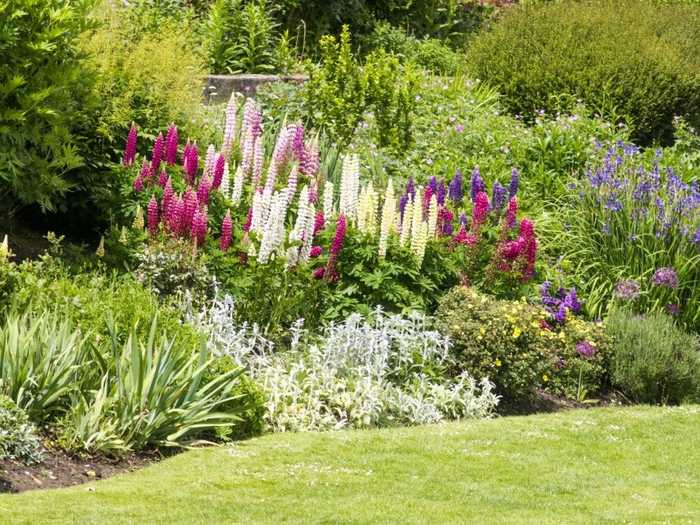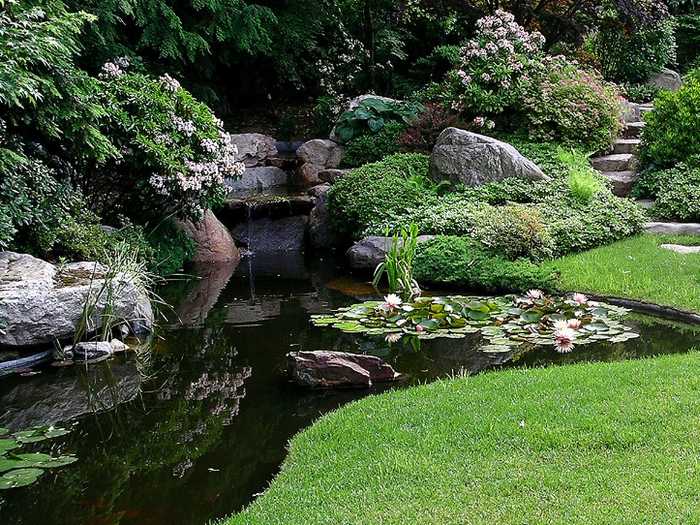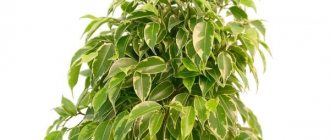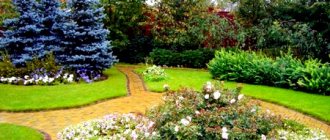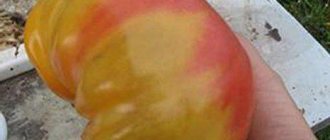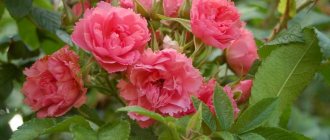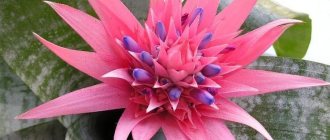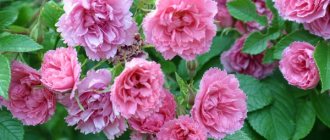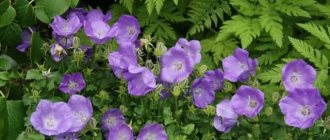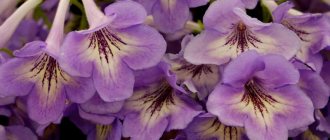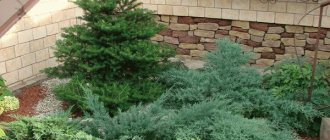Garden elements in landscape style
Paths and platforms
- execution is possible from natural stone or granite tiles, over time they will create the feeling of an old garden, where nature has made its own adjustments to the man-made landscape.

Gravel, wood cuts (or their imitation from artificial stone), any hard surfaces in the lawn (for example, the aforementioned stone) are also suitable. The lines of paths in the landscape garden are smooth, asymmetrical.
Water
- in a landscape garden, it is as naturalistic as possible: either it is a noisy forest stream, or a lake with banks drowning in reeds, with lilies on the surface.
Plants
- planted according to the principle of tiers: at the borders - tall trees, then - shrubs - from high to low, and through flower beds or dwarf shrubs, volumetric elements pass into the plane of the lawn. Often, when selecting an assortment, they strive to create a garden of continuous flowering, built on a change in the peak of decorativeness of different plants.
Vertical gardening
How to recreate the beauty of nature: rules and guidelines
When creating this style, pay attention to the numerous landscapes created by nature.
The rules of the English style require a harmonious arrangement of landings. The taller elements should be located next to the middle ones and then smoothly transition to the lowest-growing ones. Layered arrangement of plants: from tree to shrub, from flowers to lawn - the key to success.
It is important!
Despite the fact that the paths require smooth bends and winding, this does not mean that the paths from the house to the outbuildings should wind through the entire garden. Convenient location of all elements above all.
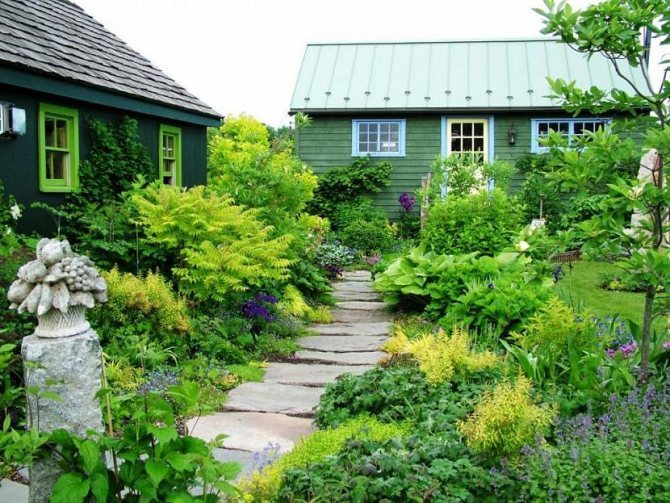

In the construction of paths, flagstone stone, wooden beams are used, imitating a naturally occurring path. This style does not tolerate "thickening" of plantings, as well as the obligatory use of every extra square meter. Space and freedom are nature's motto.
There is no need to use luxurious fountains and alpine slides if there is a natural meadow with flowers and a pond with water lilies on the site. The maximum intactness of the garden, combined with the masking of the "shortcomings" of the territory is only welcome.
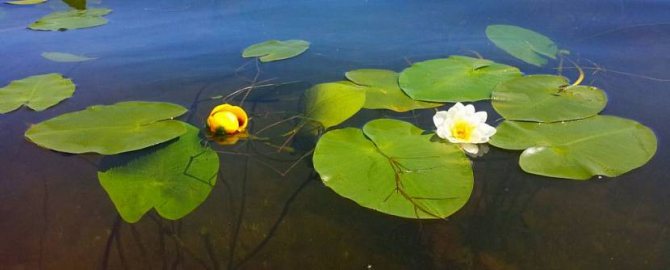

Pond with water lilies in landscape style Source
Mini ecosystem - the foundation of the garden
Take inspiration from nature itself. If you are the owner of a pine forest, then try to create backstage from young trees and hawthorn undergrowth, and decorate the lower tier with blueberries, strawberries or ferns. There is no need to radically change the landscape for this.
It is necessary to use what is on the site, with some addition of ornamental plants, which are characterized by these growing conditions.
“A garden outside a person” will not only help you to relax and immerse yourself in nature, but has another important advantage - it is low-maintenance, does not require much time and investment, does not dictate what to do every month, every day.
Plants for a landscape garden
When planning a landscape garden, almost all plants that feel comfortable in the middle lane get into the arsenal. It is possible to use conifers (various pines, firs, western thuja, junipers), as well as deciduous plants - from large trees (linden, maple, bird cherry) to dwarf shrubs (spirea, cinquefoil, barberries).In the landscape garden, decorative-leaved forms are also used - red-leaved, purple-leaved, yellow-leaved (varieties of vesicles, barberries, spirits), and plants with lush flowers (hydrangeas, clematis), and variegated forms (derens, Forchun's euonymus). When choosing plants, the illumination of the territory and the type of soil play an important role.
Selection of plants on the site
To create a landscape style, unpretentious plants are most often used. Among the flowers are mallow, irises, pansies. Also widely used directly near buildings and not far from them on flower beds crocuses and tulips, delphinium.
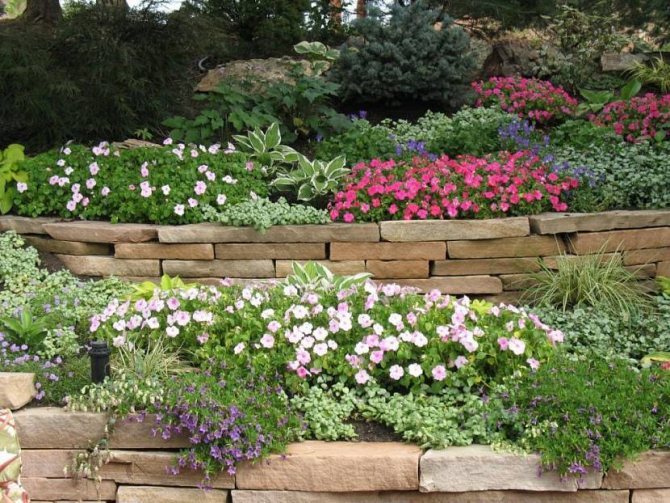

Unpretentious plants are used in landscape style.
This might be interesting!
In the article at the following link, read about how to arrange a lawn in the country: varieties of landscape solutions, care + 45 photos.
The choice of trees is not limited to anything. In the depths of the site, conifers (fir, pine) can be planted to create color. A weeping willow or even a group of trees will most organically fit near an artificial reservoir.
Note!
When discussing the landscape, one should not forget about the design of the house. Its appearance should harmoniously fit into the classic style of landscape design. It is not necessary to order the alteration of the facades, you can limit yourself to creating a "vegetable carpet" covering the outside of the house.
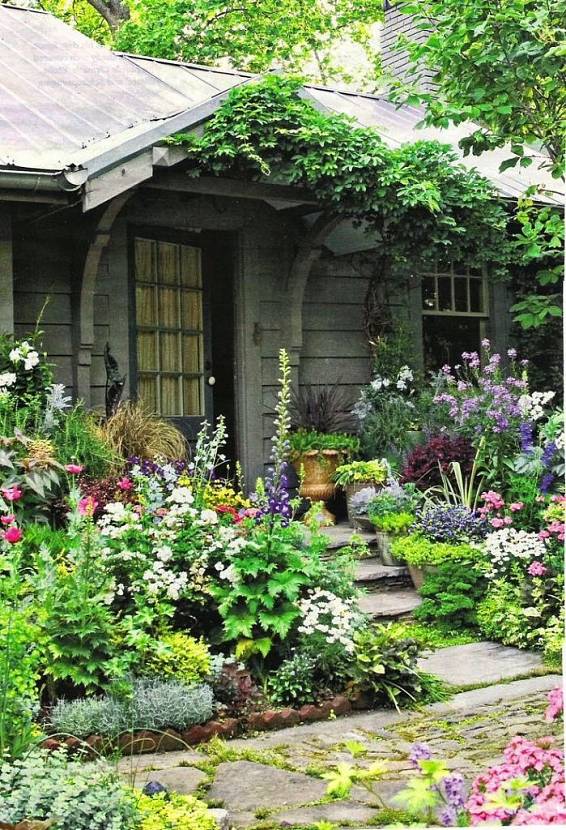

Plants decorate the outside of the house. For the south side of the house, designers recommend Chinese lemongrass, rhododendron, and for the north - fragrant hops, wild grapes.
In the same way, you can decorate the gazebo in the recreation area. For the implementation of the project, many owners of summer cottages and country houses use ordinary ivy, grapevines, climbing roses, clematis.
Fruit trees and berry bushes are most often located from the warmest and sunniest side: from the south or southeast. When creating this style, you can make a small division of the site into a garden and a vegetable garden and a recreation area with friends, a decorative corner.
DIY natural garden - swampy option
IN RECENT YEARS, A RARE FLOWER SHOW IS DISPOSED WITHOUT EXPRESS GARDENS, DESIGNED IN NATURGARTIN STYLE. PROFESSIONALS SHOW US AN EXTRAORDINARY SIMULATION OF NATURAL PLANT COMMUNITIES, BEHIND A FOREST COUNTRY, A WET MEADOW OR A PRAYER LAND.
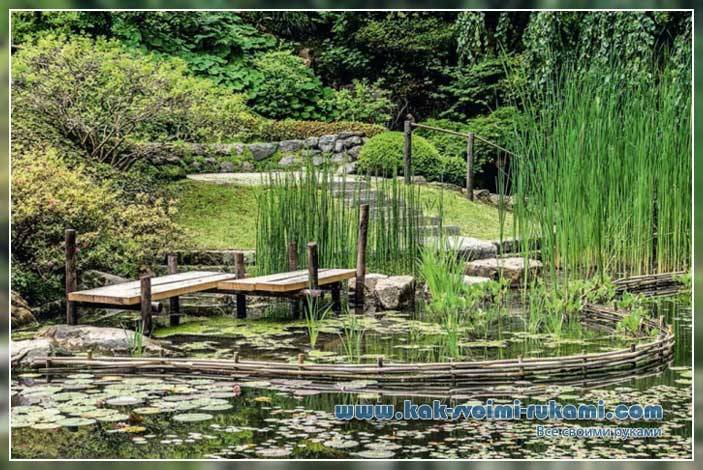

The fashion for natural gardens, which came from the West, is timidly knocking on our doorstep. The idea of imitation of nature, which became so popular with the light hand of the Dutch landscape designer Pete Udolph and his followers, has not yet captured the minds of most Russian gardeners. Many of them treat it with some caution: they say, we already have enough weeds, where else is cultivated, what grows literally everywhere! In addition, even in a purely ornamental garden with flower beds and mixborders, creating a corner in a natural style runs into a lack of space. Therefore, we are still looking at new trends, studying ornamental cereals, and they, as you know, grow slowly.
Paying tribute to the new fashion, I want to offer an excellent alternative to a cereal garden in the form of a "wet" garden, which will be quite in the mainstream, since it is also an example of imitation of a natural ecosystem.
Such a garden does not require a lot of labor, especially if you have a corner with a low relief level on your site. Now there is no need to bring in the soil with dump trucks to level it - taking advantage of this situation, create something special in your garden.
A man-made swamp must be on the one hand, it is better to surround it with shrubby vegetation from the south
Lucky!
It must be admitted that when in our country in the nineties land was distributed en masse for collective gardening, few people got the allotment of the former collective farm plowing or meadows. More and more wastelands, overgrown with small forests, and peat bogs. Most of the sites need reclamation and drainage but defined. Therefore, a swampy landscape is a phenomenon familiar to the eye of a Russian gardener and quite easily reproduced by artificial means. Moreover, very often we are accompanied by a high standing of underground waters, due to the close location of the clay layer and the soil horizon
If there is no clay on your site, you will have to make the waterproof layer yourself: without this, our water idea will work out. In nature? This type of swamp is called lowland, where water accumulates in low places and does not leave because of the m covering the clay horizon. So we, creating an artificial swamp, will have to think about how we can reproduce a similar situation.
For this, specialists usually make a clay castle, laying clay in an even layer of at least 20 cm over the entire surface of the bottom. Or they cover it with a special film to create reservoirs. You can also bury a ready-made plastic form or any other container - a used tank for boiling linen, a trough or an enamel bath found in a trash heap. I know a garden whose owner literally hunts for old discarded baths!
Soup plate
The center of the composition should be a pond, which will play the role of a reservoir supplying moisture to the surrounding area. It can be simply dug out by deepening the natural depression of the relief. In section, the structure should resemble a soup plate filled to the brim. The upper edge of such a plate is a temporary flooding zone, where water will accumulate during floods or rains. The depth should not exceed 10-15 cm. It should be understood that the pond looks like a plate only in section.
When viewed from above, its shape should not resemble a funnel from a projectile: a round reservoir looks too artificial, and our task is to get closer to natural ease. A proven option is the shape of a bean or a water lily leaf.
When the boundaries of the potential flooding zone are established, along the perimeter in several places, bury vertically pieces of pipes (asbestos-cement or sewer plastic) with a length of 50 - 70 cm. This is easier to do with the help of a garden drill. The top of the pipe should be almost level with the ground. Thus, you will create an overflow system through which excess water in heavy rains will go into the ground. This is done in order not to turn the coastal area into an impenetrable bog, stepping into which you risk losing your galoshes.
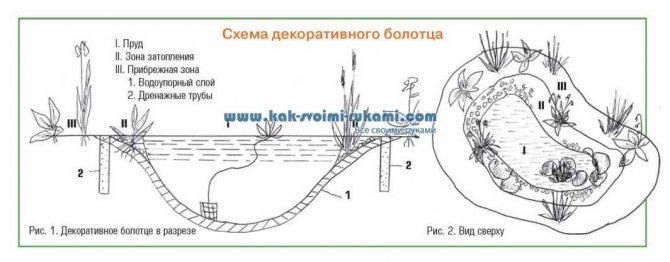

From the forest, of course
It would be good to cover the bottom of the flood zone with pebbles, which will look beautiful through a thin layer of water.
In order for a pond from a muddy reservoir of an incomprehensible color to quickly turn into a self-regulating ecosystem, you must first pour into it several five-liter bottles of water from a neighboring reservoir - a river, lake or swamp.
Thus, you will populate the pond with the necessary microorganisms and small fauna. In just a few days, only memories will remain of the dirty puddle: as if by magic, it will be filled with crystal clear water.
At the same time, in the river, you can dig directly with silt and plant some aquatic plants, such as a water lily or arrowhead, in a basket (hanging pots made of coconut fiber are suitable for this purpose).
As a result, you will get a system consisting of three zones with different modes of moisture, which determine the species composition of the flora planted in each of these zones. These are the pond itself (I), the temporary flooding zone (II) and the coastal zone (III).In zone I, that is, in a pond, aquatic plants will grow, in zone II - marsh, and in zone III - coastal plants. All of them as a whole will make a very attractive picture of a mini-garden in a landscape style, and since they will be planted in conditions that meet their environmental requirements, one can hope that they will delight you for more than one year. Having made a "wet" kindergarten, in the future you can limit yourself only to purely admiration - no additional work is required. This corner is quite rightly considered a garden for the busy.
Expert advice
To prevent adventure-seeking frogs from getting into the pipes, the ends of the pipes should be tied with a piece of mosquito netting, just like tied with a piece of cloth jars of jam, or special mesh lining should be made, fixing them on the sections of the pipe.
About the inhabitants
Nature has created a huge number of plants that feel comfortable in high humidity conditions, on acidic and waterlogged soils. Something from the proposed list you will plant yourself, guided by your taste, something, I assure you, will come to your garden on its own, as the loosestrife, meadowsweet, forest geranium and bells came to me.
I will give some tips on how best to arrange the shores of the reservoir. This man-made swamp must necessarily be surrounded by trees and shrubs on the one hand, preferably from the south. Indeed, in natural conditions, trees and shrubs grow next to any swamp, giving partial shade. A pond left without such a cover will quickly overgrow with duckweed. In addition, the process of evaporation is more intense in the sun - in the heat, you will have to add water all the time.
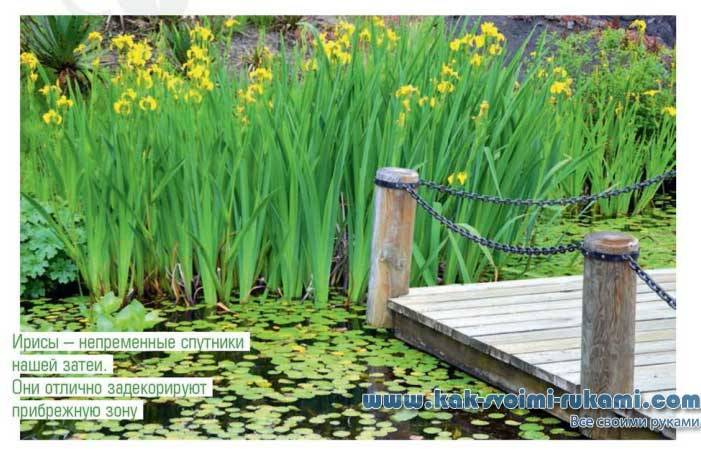

It is common to see a weeping willow near the pond. But for a small area, this decision will be inappropriate, since such a willow, familiar to us from the pictures of willow trees, is a very large tree with a powerful trunk. When you understand this, it will be too late, and you will have to part with the beautiful monumental tree. Not the best choice and planting a grafted weeping willow on a trunk. In a garden that imitates a natural plant community, such a plant will look too pretentious. For such a case, we can recommend (checked!) Red willow ‘Nana’ (krasnotal), which grows no more than 3 m in height and diameter. Its silvery leaves tremble very beautifully from the slightest breath of breeze, it forms a regular, dense spherical crown, which from time to time, once every 7 to 8 years, must be thinned out from dried branches. It lends itself well to forming, unpretentious, tolerates long-term flooding.
The swamp ecosystem is extremely harmful to the proximity of birches, which work as powerful pumps that drain the area within a radius of up to 20 m.
At the pond, it is appropriate to plant any spirits, both spring-flowering (v. Gray, v. Vangutta) and blooming in summer (v. Birch leaves, v. Japanese, v. Nipponskaya, v. Ivolistnaya). The panicle hydrangea can also be included in the tree-shrub group. In this case, just do not plant varieties with dense large caps of inflorescences such as ‘Limelight’, ‘Phantom’, ‘Silver Dollar’, capable of destroying the fragile beauty of a flower garden in a natural style. It is better to prefer varieties with lace inflorescences that create a halo of light foam, such as' Kyushu '(a tall, sprawling bush with fragrant buds),' White Dome '(a rare variety in our gardens, but worth hunting),' Brussels Lace '(the name' Brussels lace "absolutely accurately conveys the beauty of the variety).
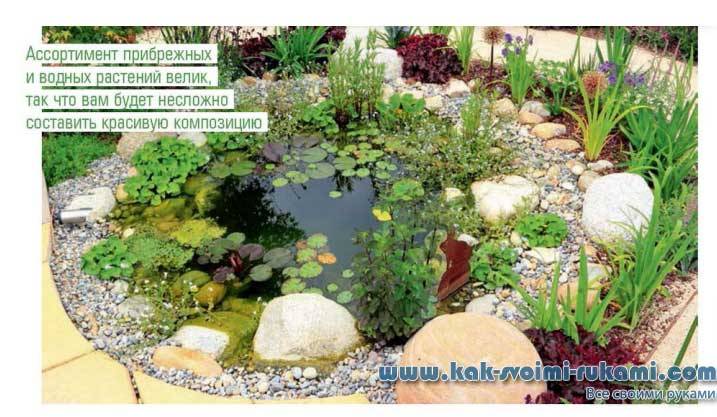

In a flooded and coastal zone with high humidity, plant plants, the names of which contain an indication that they are hygrophilous - aquilegia (catchment), swimsuit, marsh violet, marigold (found in the wild everywhere in drainage ditches), marsh geranium, swamp forget-me-not. Of the monumental plants, we can recommend Volzhanka, which grows in one place for many years, becoming more and more beautiful.If the area allows, plant thyroid darmera, its gigantic scalloped leaves will be an excellent backdrop for more modest neighbors - kupena, irises, astilbe, badanov and bruner.
Various types of loosestrife are absolutely irreplaceable. Loose-leaf, like a ground cover plant, creates a dense carpet in a short time, its lashes hang beautifully in the water. Spotted verbeynik is an unsurpassed master of a bright yellow color spot, decorative throughout the summer period. Another representative of this family is the cage-like loosestrife, a great lover of moist fertile soils, creates thickets crowned with wonderful white drooping clusters of inflorescences. The decoration of the composition will be the bird's mountaineer, popularly called the crayfish neck because of its elegant pink-lilac spike-shaped inflorescences, somewhat similar to the brushes for washing bottles.
Both loosestrife and highlander grow quickly, so it is better not to give them freedom, but to plant them in some tub without a bottom or to restrict them with a curb tape.
For ferns, the best choice is the one you bring from a nearby forest. It can be female or male ferns, these species ferns grow compactly. They must be taken in early spring, when tightly twisted "snails" appear above the ground; with a later transplant, success will be in question.
About frogs
We must not forget about other important inhabitants of the swamp kingdom. As you probably already guessed - these are frogs, where without them! They are extremely useful creatures for the garden.
They eat a large number of unwanted insects, slugs, caterpillars and mosquito larvae. The number of species of harmful insects destroyed by frogs and toads, according to experts, is 2 - 3 times higher than that of birds. They hunt mainly at night, destroying all kinds of pests of fruit, berry and vegetable crops - they destroy the larvae of the harmful Colorado potato beetle, wireworms, bedbugs, eat weevils, raspberry beetle, aphids and ants.
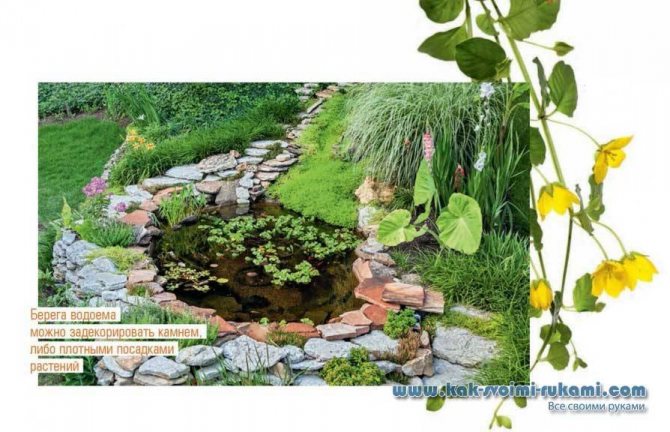

Therefore, frogs should be attracted to your garden in every possible way. It only at first glance seems that there are many of them, as once upon a time in childhood. Their number is inexorably decreasing. Swamps are being drained, highways are being laid through protected areas, summer cottages are advancing from all directions. Therefore, our task is to create appropriate conditions for frogs to live and reproduce. And our swamp will come in handy.
But I urge you not to make a ceremonial version out of the reservoir, made according to all the rules of garden design, with a fountain and lighting, which you will not be ashamed to show your neighbors. We have other goals - to build a maternity hospital for frogs and at the same time a sanatorium, a kind of rehabilitation center, such a frog spa. In a quiet, calm place, preferably not in the sun, but in a light floor, drive. And no circulation of water - a quiet, sleepy life, like in a pond with the tortoise Tortilla.
Under favorable conditions, frogs will populate your reservoir, lay eggs there, from which a new generation of frogs will soon appear. Equip the banks in such a way that the frogs can freely get to the shore. To do this, you will need to build a walkway by dropping a board or snag into the water. This is especially necessary if the pond has steep banks. With sufficient depth and thickness of the silty layer, frogs can burrow there for the winter, hibernating. Naturally, no pesticides and fertilizers should get into the water with rain. Therefore, no spraying or fertilizing nearby!
The frogs wait out the heat, sitting somewhere in the sink under a bush of hosts. There must be such secluded corners in the garden. You can specially equip a shady shelter by adapting, for example, an unusable ceramic pot with a broken edge for this case.Place it upside down in the shade, the broken edge forms a hole - a wonderful structure, frogs should appreciate it!
Water decor
The usual stamps like a broken jug from which water is poured out are not suitable here.
Figures of a plastic heron or stork will simply scare away all the frogs. How do they know they are not dangerous? In our garden, we limited ourselves to two ceramic figures, disguising them in the coastal grass - you will not immediately notice. These are turtles and a frog as a symbol of the frog kingdom. I wonder if real frogs have recognized their foreign origin in the friend / foe system? Judging by their serene breaststroke, they don't really care.
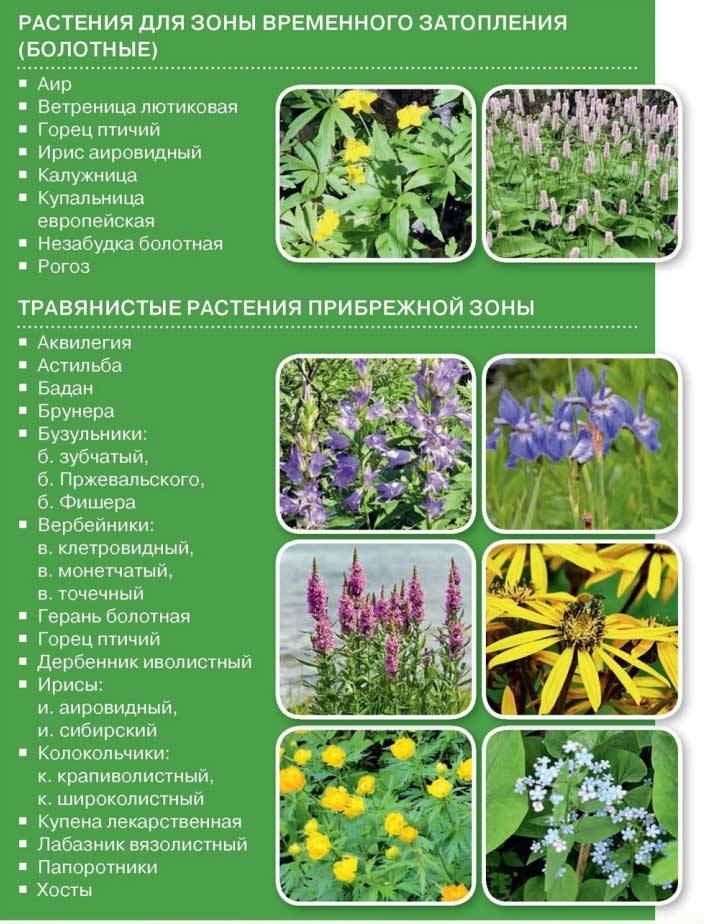

PLANTS FOR TEMPORARY FLOODING ZONE (Bog)
- Calamus
- Buttercup anemone
- Bird highlander
- Iris calamus
- Kaluzhnitsa
- European swimsuit
- Forget-me-not marsh
- Rogoz
HERBAL PLANTS OF THE COASTAL AREA
- Aquilegia
- Astilba
- Badan
- Bruner
- Buzulniki:
- b. toothed,
- b. Przhevalsky,
- b. Fischer Verbeiniki:
- in. cell-like, c. monotonous,
- in. point
- Marsh geranium
- Bird highlander
- Willow loosestrife
- Irises:
- and. calamus,
- and. Siberian
- Bells:
- to. nettle-leaved,
- because broadleaf
- Medicinal bought
- Meadowsweet
- Ferns
- Hosts
<о. пупасова-максимова,="">
TOOL FOR MASTERS AND MASTERS, AND HOUSEHOLD GOODS VERY CHEAP. FREE SHIPPING. RECOMMENDED - CHECKED 100% THERE ARE REVIEWS.
Below are other entries on the topic "How to do it yourself - a householder!"
- Do-it-yourself Egyptian corner in the country. Rest corner in the Egyptian style ...
- Do-it-yourself oriental stool Oriental stool - how is it ...
- What style to create a garden? Landscaping Tips CREATING A DREAM GARDEN If you still ...
- DIY patchwork chair (master class) How to make a chair in the style of ...
- Do-it-yourself bedside table decor in oriental style Do-it-yourself bedside table decor - ...
- Do-it-yourself courtyard with a rustic flavor House in the village with your own hands ...
- DIY Japanese-style garden (planting plan) Creating a Japanese-style garden TIP: ...
Subscribe to updates in our groups and share.
Let's be friends!
With your own hands ›Summer cottage garden and vegetable garden› Garden in a natural style - design principles
Tips for designing a garden in a landscape style.
- When selecting planting material, the dynamics of plant growth plays an important role. It is quite possible to buy a small spirea or white dogwood, in a year or two they will practically reach their maximum size. But it is not recommended to buy a spruce 0.5 meters high.
- Plants look much more advantageous if they are planted in small clumps, and not one by one. By the way, this is one of the differences between European and Russian landscape design.
- The landscape style excludes the presence of topiary forms, explicit shearing of plants. But this does not mean that everything needs to be left to chance - many plants are quite aggressive and able to kill weaker, but highly decorative species. The main thing is that the interference is not conspicuous: no one will notice the protective strip dug into the ground and limiting the variegated dampness, or the slightly pruned girlish grapes that climb under the roof of the house.
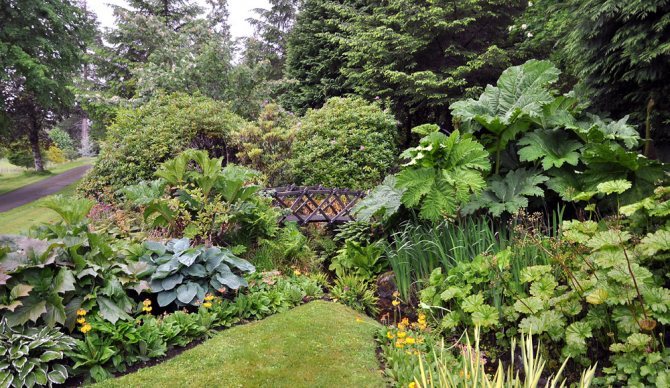

In conclusion, I would like to note that although the landscape garden is one of the most widespread in the landscape at the moment, it is not as simple as it seems at first glance. Imitation of nature is one of the most difficult tasks, but in return you will receive a lush garden, beautiful at any time of the year, birdsong and a feeling of harmony with the world around you.
Schemes and plans of the English style
English-style garden layouts can have many variations depending on the location of the site and its total area.
However, there is a general plan:
- the laying of paths is aimed at connecting the house with other objects, as well as at bypassing all viewpoints;
- the main space of the site remains as free as possible;
- trees are planted in groups on small elevations to cover recreation areas;
- the plot provides easy access to any corner of the garden.
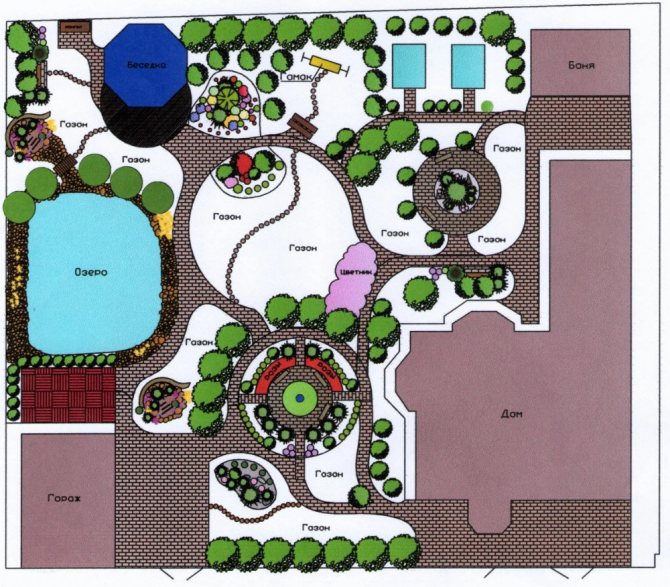

The English landscape style continues to enjoy widespread popularity among homeowners. Its main value lies in the fact that, despite its aristocracy, it is suitable both for framing luxurious cottages and simple country buildings. The main nuance that allows you to achieve the desired appearance is following the general concept: minimal interference and harmony with the surrounding nature.
Chinese style in landscape design
Along with the English style, other types of landscape design, similar to landscape design, have become quite popular. One of them is the Chinese style.
This direction is based on the Eastern worldview, according to which everything in nature is permeated by qi energy. Its streams freely circulate only along "miraculous" contours that do not have straight lines, sharp corners and symmetry.
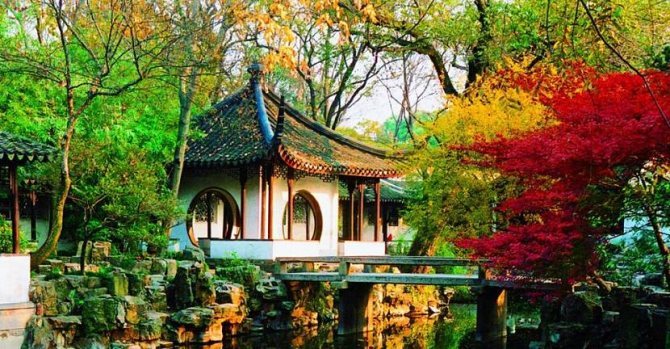

Chinese Style in Landscaping Source
This might be interesting!
In the article at the following link, read about about a landscape design project: design stages and examples of the best solutions in the photo.
In addition to this main feature, the Chinese landscape style has the following features:
- All exterior items are completed compositions
.
Alpine slide
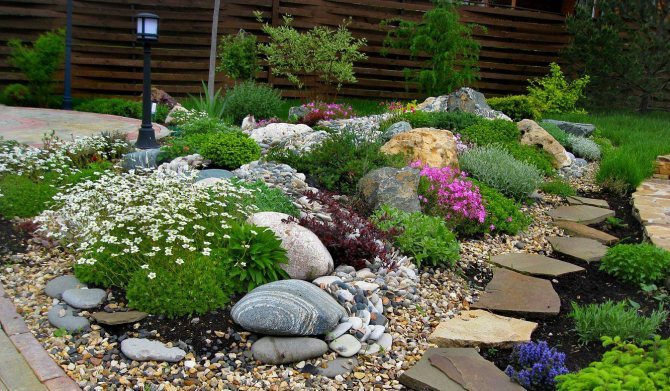

The construction of flower gardens, in particular alpine slides, is one of the most frequent and favorite types of flower decoration. And it requires compliance with the following rules:
- imitation of a natural mountain landscape does not allow symmetry, clear patterns and spirals. Natural naturalness is needed.
- the use of stones of different shapes, sizes, textures and types. A combination of no more than 3 types in one composition is allowed, so as not to overload the landscape.
- the use of a purchased, good stone for the front part. Beautiful shape and shade are welcome. It is better not to use the remains of bricks and stones found in the garden. The rock garden will lose its decorative effect. The maximum amount of such material is suitable for preparing the base and provided that such stones will not be visible. A good stone is the key to a beautiful alpine slide.
- competent location of the rock garden in the garden. They often use a beautiful ceremonial place that you want to emphasize.
- when planting plants, those are used for which there will be enough space for full growth and development.
- the ratio of the size of the site to the structure. The alpine slide has an impressive size, a small area is not suitable for it.
- when placing the composition near the fence or walls of the house, it is also necessary to take into account the height of the structure and the rock garden.
Knowing and observing all of the above features, you can independently create an alpine slide on your site.
Flower garden in natural style
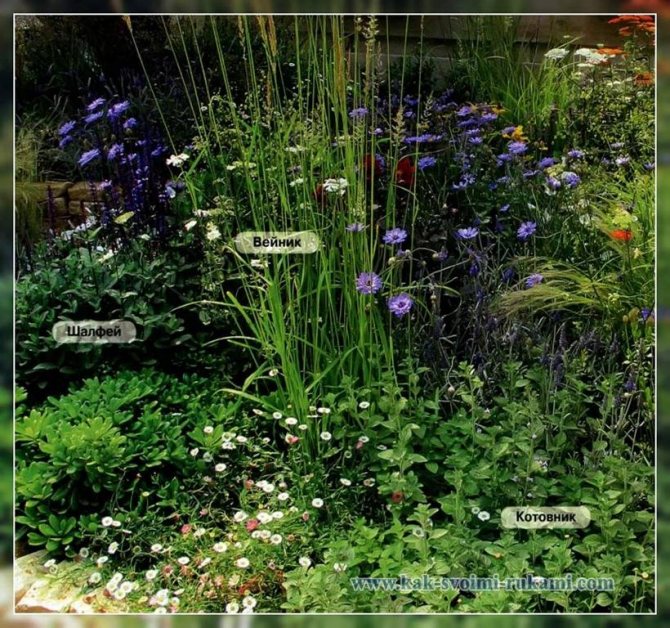

Recently, flower beds made in a natural style have become more and more popular.
Confirmation of this is the author's gardens of the participants of fashionable flower shows held all over the world. And this is not surprising, because natural gardens are full of charm and have some kind of attractive power.
Natural outlines of curtains, calm colors give us a feeling of comfort and coziness. Another important detail - the correctly selected assortment - allows you to reduce the care of such compositions to a minimum.
In a natural flower garden, decorative grasses will look ideal - both perennial (sharp-flowered reed grass, rod-shaped millet, turfy pike), and annual (hare tail, shaker, bristle grass, canary grass, maned barley). Giving the flower garden dynamics, they will also create the required volume, as they go well with almost all plants.
Use annuals (cornflower, annual flax, chrysanthemum chrysanthemum, samoseyka poppy, escholzia, resin, kosmeya) if your composition of perennials was planted quite recently and the plants did not have time to gain the required volume. Fill empty spaces with them. You can use ready-made seedlings or sow seeds of cold-resistant species directly into open ground (late April - early May).
The flower garden shown in the photo in its appearance is quite consistent with the concept of "natural", although not all plants planted in it can be found in nature. And this, by the way, is one of the principles of selecting companions for such compositions. For natural flower beds, you can also select varietal plants with suitable physiognomic qualities, but the basic rule is to choose varieties with a simple flower shape.
If you really wanted to create a flower garden in a natural style on your site, but you do not know where to start, take the presented composition as a basis.
The center can be a low tree or shrub with bluish foliage, such as rowan aria or silvery elk. Such a flower garden will look good under a dangling ‘Youngii’ birch tree with drooping branches. The structure is created by clumps of yarrow with bright orange inflorescences and purple oak sage. Clear vertical lines - sharp-flowered reed grass and turfy pike. The filling plants are Fassen's catnip, narrow-leaved lavender, maned barley, large shaker. Bright purple spots - hybrid penstemon, alpine burnet, annual dahlia with decorative foliage.
Advice
When designing, try to select plants according to the principle of contrast and nuance. In this case, the flower garden will turn out to be very expressive. Contrast and nuance can be expressed both in the shape of the inflorescences and in color. For example, yarrow and cereals are a contrast in shape, sage and catnip are a nuance in color.
How to create an English-style garden in Russia
It is possible to create a garden in an irregular style, and being at a very great distance from Foggy Albion - in Russia. And, in general, the task is not too difficult. The main thing here is attention to detail.
It is important to understand that the landscape garden only looks maintenance-free. In fact, maintaining its appearance requires a fairly large investment of time and some effort.
The ideal plot for an English garden should be large enough - preferably at least ten to twelve acres. Shaded, with high air humidity. It is good if it is located at the edge of the forest. Even better is the presence directly in the territory of several large wild trees. Also, a plus will be the presence of a reservoir, for example, a small pond or river.
The house must be hidden from view. Ideal - location in the depths of the site, closer to the edge. You can also disguise it with climbing plants blown up the wall, such as grapes or hops. Another option is to “hide” the building behind tall trees.
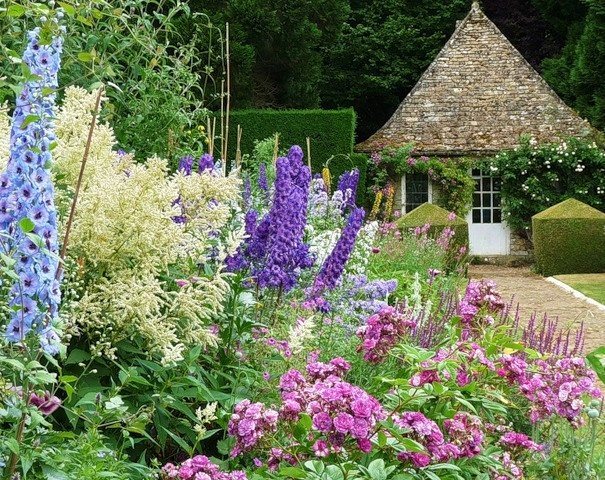

The first step is to sketch on paper a plan for the future composition. Clearly determine where the lawn will be, planting plants, decorative elements, how the paths should run. In this case, it is necessary to take into account the peculiarities of the terrain - hills (or just small hills), lowlands, reservoirs, large trees.
Killerton House Garden, near Exeter, Devonshire.
The entire territory of the site can be surrounded by a hedge around the perimeter. This will be a completely appropriate solution, even if the site already has a fence. And so that this element does not look artificial, they plant it not with a solid wall, but breaking it up with groups of trees and shrubs. An alternative option would be to run the vine over an already existing fence.
The basis of the garden, made in the English style, is a lawn.It can be either solid or broken into several small lawns, but it should take up a lot of space. The grass cover needs regular haircuts and watering. Groups of shrubs, both decorative and fruit and berry, are planted along its edges. The main thing is that they are not too high. You can also plant bushes in the center of the lawn, and create picturesque flower beds around the edges.
In some secluded corner, in the shade of trees, you can arrange a recreation area with benches and, possibly, a small table. A brazier can also be located here. You can fence this place with green spaces and start a path to it. It would also be appropriate to arrange the entrance here in the form of an arch. It is also permissible to cover the earth in this place with gravel, or lay it with tiles, brick or tree bark. There may be several such corners in the garden.
Secluded corners of the garden in Lincolnshire
An obligatory element of the English style is a reservoir. If there is no natural pond on the territory, you can dig it yourself. The banks can be planted with near-water plants, in particular, willow. And in the water, water lilies will look good, as, indeed, a simple duckweed. If there is a small river or stream, you can build a bridge.
As a last resort, you can simply install a small pool or fountain somewhere, decorating it accordingly.
The main color in an English garden is green. But the more shades it has, the better. Trees, shrubs and flowers are planted in small groups in no particular order. It is imperative to combine wild plant species with cultivated ones, conifers with deciduous ones.
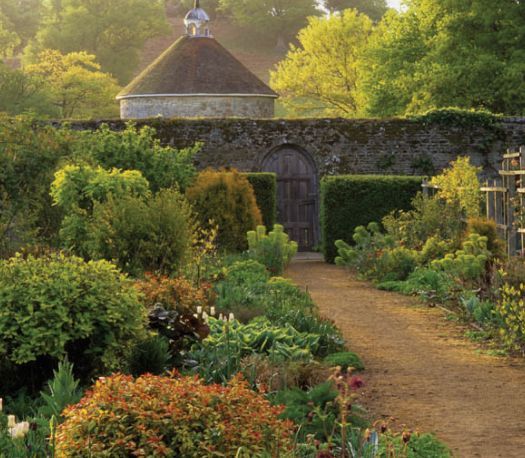

Garden at Peram Park, West Sussex.
The flower garden should be in the same color, but may contain different types of plants.
As additional decorations, you can place sculptures around the garden. Small picturesque ruins will look good. A good solution would be to place a sundial in one of the bright areas. Flower beds and plants in pots and special containers will also be appropriate. Of course, all these details should be organically integrated into the overall picture.
Fashion stars for blooming ensembles in a natural style
The main tools for creating lush landscape compositions are those perennials that are amazingly easy to care for. Style favorites have not changed under the influence of fashion, although their list has expanded significantly. Today, at the peak of popularity, there are plants with textural expressiveness, the ability to bring elements of surprise, with colorful saturation, longevity and bright personality. With the help of such perennials, placed both one at a time, and in groups, mixed in chaos, they create "thickets" of the desired shape. Plants do the work themselves - only after a few seasons they create the picturesque picture they were striving for at the beginning. And they always surprise with their unexpected "behavior".
Fashion favorites include: foxglove, helenium, bells, lupines, geraniums, poppies, centranthus, kupena, irises, smolevka, aquilegia, mullein, ash, ornamental grasses, sage, aconite, waldsteinia, veronica and catnip, oregano and larch. And this is just a rough list of plants that will help you complete the task of creating a powerful and lush landscape ensemble. Plants choose strong, sturdy plants with a good ability to spread and conquer territory.
Letniki are not used in such compositions - landscape flowering arrays are made only of perennials. But most of the plants are capable of self-seeding, sprawling, spontaneous spreading, which adds a sense of improvisation to the compositions.
If you need to place shrubs in the composition, and even more so, if for a beautifully flowering background it is desirable to introduce a tall woody one to enrich the vertical structure or give depth to the entire ensemble, then it is better to make a choice from among low and medium-sized shrubs and trees that bloom beautifully, but also, in addition flowering period, will delight you with their eloquent stylistic expressiveness. Mountain ash, bird cherry, goat willow, irga, honeysuckle, barberry - these are the main favorites for the role of dominant soloists.
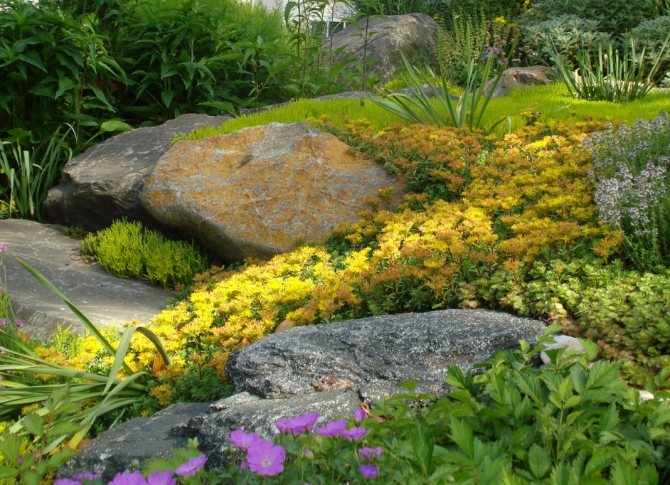

Natural landscape
Decorative qualities of the garden in the English style
The main decorative element of the garden in the English style is plants. Flower gardens, groups of trees and shrubs, hedges. A variety of vines, entwining fences, a house, sculptures, bridges and benches will also be good. Also, do not forget that one of the mandatory signs of an irregular style is plants in containers or pots.
The main condition for choosing such green decorations is their compliance with the terrain and climate in which the garden is located. Exotic plants will be out of place here.
Great Dixter Estate, located in Northiam, East Sussex, East Sussex
One of the most popular flowers in landscaped gardens is roses. However, they are not required. Perennial species are preferred. The flowers may not differ in brightness, but in this case the leaves should be large, lush, of an unusual shape.
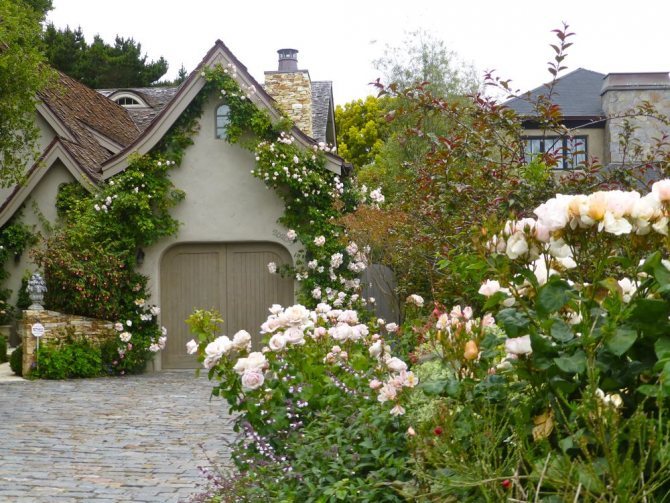

An English-style rose garden in Carmel, California.
The materials of the architectural elements in such a garden must be natural. The paths are brick or stone, or simply covered with gravel. It is also possible to use tree bark. Metal parts (for example, bridge railings or bench armrests) are usually forged or cast.
When decorating a home and garden, as a rule, the same materials are used.
Also, artificial caves or grottoes, shallow, but secluded, can be used as decorations. The arches entwined with vegetation and located in the secluded corners of the statues will fit well into the overall picture.
An obligatory element of the English style is a reservoir. Ideally, a natural pond or several streams, but you can get by with an appropriately decorated fountain. If a descent to the water is provided, then it is best to make it in the form of a simple path without any additional decorations.
Shapes and sizes for a garden in a natural style
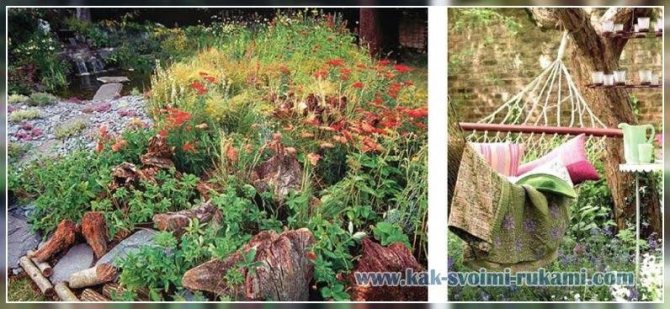

To create an out-of-man experience in the garden, consider species with different inflorescence shapes: panicles, umbrellas or balls. However, do not use the standard mixborder high-altitude approach, where the tallest plants are in the background and the lowest are in the foreground.
Appreciate the charm of natural beauty when bright or textured flowers peep through the tall openwork "veil" plants. Try as a "veil" to plant a burnet or a basil with a Veronica, a loosestrife or a black cohosh mysteriously peeking out from behind.
Flowers and Plants
A landscape-style garden cannot be set up without plants and flowers. They not only make the territory attractive, but also make it more environmentally friendly. It is very important to carry out landscaping correctly.
The main principle is compatibility. It is necessary that the plants located in the neighborhood do not harm each other, but contribute to rapid growth and flowering. By grouping cultures together, it is easier to care for them as they often have similar needs.
It is also important that plants match in color and shape, in species and flowering time. It is impossible to take all this into account without special knowledge, therefore, if the experience in gardening is small, it is worth contacting a specialist.
The choice of species is due to the peculiarities of the climate and soil on the site, as well as the style of decoration. It is advisable to choose flowers that will be in harmony with the environment so that there are no contradictions in the color palette. Although some design solutions allow for contrasts.
If you plan to leave the garden in the country, you should think about how to arrange it so that it looks appropriate. And choose flowers, shrubs and trees in accordance with the species composition of the crops grown.
Photo:
Features of a natural garden
Creating a natural garden with your own hands is an activity that is within the power of almost every gardener, the main thing is to be patient and give time to natural forces to do the main work themselves.The peculiarity of such gardens in a natural style is the variability of their appearance, the dominant plants replace each other from year to year.
It is important that a certain balance be maintained between the parts of the garden, harmony reigned between wild plants and individual plantings introduced by the hand of a skilled gardener.
Such changeability, naturalness of the processes taking place in the garden appeals to many nature lovers.
The main signs of an English garden
These ten signs will allow you to unmistakably distinguish a landscape garden from any other:
- Free layout, creating the feeling that the garden is not created by man, but absolutely natural.
- Smooth, curved lines.
- Small winding paths, rather like forest paths.
- A combination of coniferous and deciduous trees.
- The flower beds are not variegated, monochromatic.
- The presence of both cultivated and wild plants in the garden.
- Large neat lawn.
- Using plants in containers.
- The alternation of open and closed spaces: lawns with flower beds and groups of trees.
- Selection of plants typical for the given natural conditions.
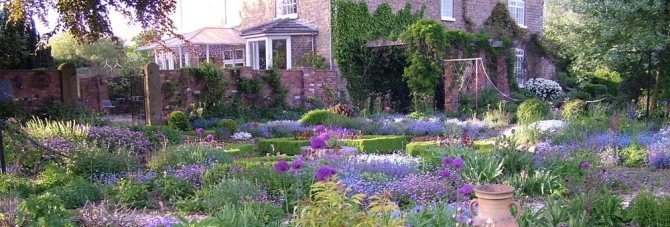

Where to begin?
You should start work on the design of the site with a decision - who will do this: a specialist or the owners themselves. The landscape designer will select the best option and think over the details, and the execution will be faster. But his services are expensive. Therefore, they often do such work independently. This is somewhat more complicated, but much more interesting.
If you decide to decorate a summer cottage in a landscape style with your own hands, then you need to draw up a work plan. Take into account the features of the area, decide what you would like to see, think over the location of objects. This can be helped by a computer on which you can execute the plan in 3D. You can also make a sketchy plan on graph paper.
It is necessary to highlight the zones, having thought over the location of the objects. The site usually contains outbuildings, a vegetable garden, flower beds, a garden, and more. All this must be placed harmoniously and paths and paths outlined. Straight lines are best avoided - unusual shapes add attractiveness.
When placing objects, you need to take into account the peculiarities of the territory, as well as what is already located on it. You also need to think about lighting and water supply to areas where it is needed. The last item is the calculation of costs.
The microclimate of the garden
When creating a natural garden with your own hands, you need to know it well about the microclimate so that new plantings take root well. Experienced gardeners know that the southern slopes are warmer and cooler in the lowlands and flat areas. A hedge will be better located if gusts of wind break on it, which will save the reservoir from excessive drying out. The stones scattered near the pond accumulate heat during the day and release it at night.
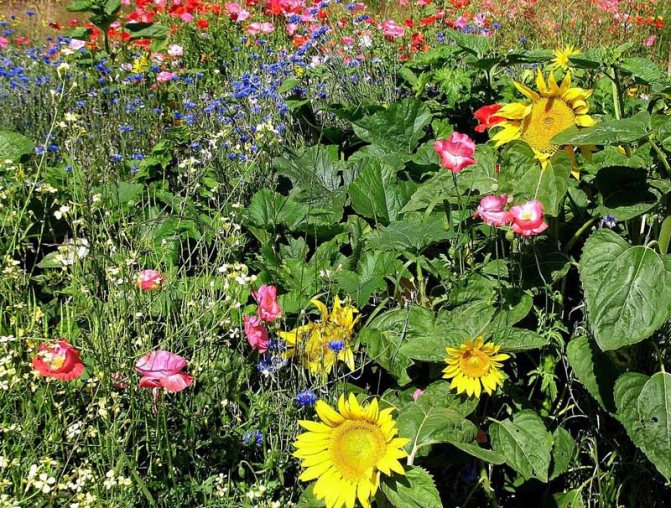

Distinctive features of the style
- uneven relief, characterized by the alternation of flat areas with hills, slopes, ravines, natural reservoirs;
- the illusion of naturalness and natural chaos - free space planning, absolute asymmetry, absence of straight lines;
- the house is located in the depth of the site or hidden behind trees;
- the presence of architectural structures;
- combining individual elements of the garden using winding paths made of natural stones or sawn tree trunks;
- the presence of a well-thought-out system of paths, following which it is possible to see the change of various picturesque landscapes;
- the absence of a point from which you can see the whole garden: thus, the perspective opens gradually;
- all reservoirs, even of artificial origin, should have a pronounced natural character: an uneven coastline, natural framing (pebbles, sand, near-water plants);
- garden flowers are planted near the house, in the garden, field and forest perennials are preferred.
| Home → Useful → Garden and park design → Landscape garden The landscape style originated in the 17th century in England. During this period, the lands of foggy Albion were cleared and ennobled, fields were actively developed, plantations were settled, territories were conquered from forests, etc. One of the areas of landscaping was the design of plots around the cottages. It so happened that here the principles of oriental gardens had an active influence on the design thought. In general, Eastern culture was popular at that time in England, since this country was in close contact with India, which was its colony. Officials, civil servants, the military constantly shuttled from England to India and back: they brought a lot of knickknacks, household items and jewelry, as well as design ideas for arranging a home and garden. Since the oriental gardens were distinguished primarily by their splendor and naturalness, natural naturalness, it was these features that were introduced into the landscape culture of England. As a result of this process, the landscape style that still exists today was formed. |
Layout
The architecture of the garden in a landscape style organically fits into the landscape, repeats its colors and proportions, natural reservoirs - ponds, lakes and streams, are romantically hidden in thickets of freely growing trees. All layout lines are given a sinuous, asymmetrical shape, and lawns are streamlined.
Other characteristic features of the free style are the inclusion in the landscape composition of the surrounding species with the help of plantings - wings, as well as the use of the features of the relief with its hills and depressions. If the site is flat, make an artificial bedding. In such gardens, multi-tiered dense borders - mixborders are also used. Among the materials, preference is always given to untreated natural stone, wood, and if concrete and brick are used, then they must be covered with cracks and overgrown with moss. All this enhances the romantic appearance of the garden, giving it the charm of natural neglect.
The landscape style makes it possible to apply the techniques of visual deepening and increasing the space, which is especially important for small gardens. There are few flowers in the English garden, they are usually planted in compact groups. The flower beds are located near the house or reservoir. Plants are mostly heterogeneous. Combinations of plants in color and shape play an important role.
The house in the landscape garden does not prevail over the garden, but, on the contrary, hides in its foliage.

